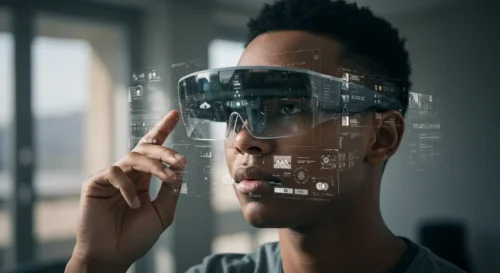The world of gaming is constantly evolving, with consoles at the heart of this dynamic landscape. From the early days of pixelated graphics to the hyper-realistic worlds of today, gaming consoles have consistently pushed the boundaries of technology and entertainment. But what does the future hold? While the current generation of PlayStation and Xbox consoles offer incredible experiences, several emerging technologies are poised to reshape the future of gaming. This article will explore four key technologies that are likely to influence the next generation of gaming and beyond, examining their potential impact on how we play and interact with games.
Next-Gen Gaming Consoles and the Future of Interactive Entertainment
The latest iterations of gaming consoles, the PlayStation 5 and Xbox Series X|S, represent a peak in traditional console design. They boast powerful processors, stunning graphics capabilities, and innovative features that deliver immersive gaming experiences. These consoles have set a new benchmark for performance and graphical fidelity, offering players breathtaking visuals and smoother gameplay. However, they also represent a culmination of existing console technology. The future of interactive entertainment is likely to extend beyond the traditional console box, embracing new forms of interaction and delivery.
I. Introduction: The Evolving World of Gaming
Did you know that the global video game market is worth hundreds of billions of dollars, with consoles playing a pivotal role? From casual gamers to esports enthusiasts, consoles have become a central hub for interactive entertainment, shaping popular culture and driving technological innovation. The latest generation of consoles, spearheaded by the PlayStation 5 and Xbox Series X|S, represents a significant leap forward in gaming technology, offering unprecedented levels of performance, graphical fidelity, and immersive experiences. But while these powerful machines dominate the current gaming landscape, the future of interactive entertainment is being shaped by even more transformative technologies, hinting at a future beyond traditional consoles.
The history of gaming consoles is a fascinating journey of technological advancements and evolving entertainment preferences. From the pioneering days of Atari and Magnavox Odyssey in the 1970s to the rise of Nintendo, Sega, and Sony in the following decades, consoles have consistently pushed the boundaries of interactive entertainment. Each generation has brought improvements in graphics, sound, gameplay, and online connectivity, culminating in the sophisticated systems we have today.
The PlayStation 5 and Xbox Series X|S offer a powerful combination of cutting-edge hardware and innovative features, setting a new standard for console gaming. However, the future of interactive entertainment is not solely defined by these powerful boxes under our TVs. Technologies like cloud gaming, virtual and augmented reality, and artificial intelligence are poised to revolutionize how we play and interact with games, opening up new possibilities beyond the traditional console experience. This article will explore the impact of the current generation of consoles and delve into the technologies that are shaping the future of interactive entertainment, exploring what lies beyond the console as we know it.
II. The Power of Current-Gen Consoles
The current generation of gaming consoles, primarily represented by the PlayStation 5 (PS5) and Xbox Series X|S, marks a significant technological leap compared to their predecessors. These consoles deliver a dramatically enhanced gaming experience through powerful hardware, innovative features, and a focus on speed and immersion.
Processors and Graphics Processing Units (GPU):
Both the PS5 and Xbox Series X|S utilize custom-designed processors based on AMD’s Zen 2 and RDNA 2 architectures, respectively. These powerful processors provide a significant boost in processing power, enabling smoother gameplay, more complex game worlds, and advanced AI capabilities.
- PS5: Features an 8-core, 16-thread AMD Zen 2 CPU and a custom AMD RDNA 2 GPU with 10.28 TFLOPS of computing power.
- Xbox Series X: Boasts an 8-core, 16-thread custom AMD Zen 2 CPU and a custom AMD RDNA 2 GPU with 12 TFLOPS of computing power, making it the most powerful console on paper.
- Xbox Series S: A more affordable option, the Series S features the same CPU architecture as the Series X but with a less powerful GPU (4 TFLOPS) and less RAM. It targets 1440p resolution gaming.
This raw processing power translates to higher frame rates, more detailed graphics, and more complex physics simulations in games.
Fast SSD Storage:
One of the most significant advancements in this generation of consoles is the adoption of solid-state drives (SSDs) as the primary storage medium. Unlike traditional hard drives, SSDs offer dramatically faster read and write speeds, resulting in:
- Near-instantaneous Loading Times: Games load in a matter of seconds, drastically reducing waiting times and allowing players to jump straight into the action.
- Faster Game World Streaming: SSDs enable developers to stream game world data much faster, allowing for larger, more detailed, and seamless open worlds.
- Improved Game Performance: Faster data access can also improve overall game performance, reducing stuttering and improving responsiveness.
New Controllers:
Both PlayStation and Xbox have introduced new controllers with innovative features that enhance the gaming experience:
- DualSense (PS5): The DualSense controller features haptic feedback, which provides more nuanced and realistic vibrations, and adaptive triggers, which can simulate the tension of pulling a bowstring or pressing the brakes in a car. These features significantly enhance immersion and provide a more tactile gaming experience.
- Xbox Wireless Controller (Xbox Series X|S): While maintaining a similar design to the previous generation’s controller, the new Xbox Wireless Controller features improved ergonomics, a more responsive D-pad, and a dedicated share button for capturing and sharing gameplay moments.
Comparison with the Previous Generation:
The current generation of consoles offers a substantial improvement over the PlayStation 4 and Xbox One in virtually every aspect:
- Significantly improved graphics and performance: Higher resolutions (up to 4K and even 8K), higher frame rates (up to 120fps), and more detailed graphics.
- Dramatically faster loading times: Thanks to the SSDs, games load much faster than on previous-generation consoles.
- Innovative controller features: The DualSense’s haptic feedback and adaptive triggers offer a new level of immersion, while the improved Xbox Wireless Controller provides a more responsive and comfortable experience.
The power of the current-gen consoles has enabled developers to create more ambitious and immersive gaming experiences, pushing the boundaries of interactive entertainment.
III. Technologies Shaping the Future of Consoles
While the current generation of consoles offers a significant performance boost, several key technologies are poised to further revolutionize the gaming experience and shape the future of interactive entertainment.

Cloud gaming allows players to stream games directly to their devices over the internet, eliminating the need for powerful local hardware. The game is rendered on powerful servers in the cloud, and the video stream is sent to the player’s device, while their input is sent back to the server. This opens up possibilities for playing high-end games on less powerful devices, such as smartphones, tablets, and even older consoles.
- Services: Key players in the cloud gaming space include:
- Xbox Cloud Gaming (xCloud): Offered as part of Xbox Game Pass Ultimate, xCloud allows subscribers to stream a library of Xbox games to various devices.
- PlayStation Plus Premium: This tier of PlayStation Plus offers cloud streaming of select PlayStation titles, including classic games and some newer releases.
- Advantages:
- Accessibility: Play high-end games on less powerful devices.
- No Downloads or Installations: Start playing games instantly without waiting for downloads or installations.
- Cross-Device Play: Play games on various devices, such as smartphones, tablets, PCs, and TVs.
- Disadvantages:
- Internet Dependency: Requires a stable and high-speed internet connection.
- Latency: Network latency can introduce input lag, affecting gameplay responsiveness.
- Data Consumption: Streaming games consumes significant amounts of data.
Virtual and Augmented Reality (VR/AR):

Virtual Reality (VR) creates fully immersive digital environments that block out the real world, while Augmented Reality (AR) overlays digital information onto the user’s view of the real world. Both technologies have the potential to significantly enhance the gaming experience.
- Potential for Consoles: Consoles can provide the processing power needed to run demanding VR/AR experiences.
- Existing Solutions: PlayStation VR and PlayStation VR2 are examples of VR headsets designed for use with PlayStation consoles.
- Perspectives: While VR gaming has gained some traction, AR gaming on consoles is still in its early stages. Future advancements in AR technology could lead to more compelling and immersive AR experiences on consoles.
Ray Tracing:
Ray tracing is a rendering technique that simulates the way light interacts with objects in a scene, creating more realistic lighting, shadows, and reflections.
- Impact on Graphics: Ray tracing enhances the visual fidelity of games, making them look more realistic and immersive.
- Implementation in Consoles: Both the PS5 and Xbox Series X|S support hardware-accelerated ray tracing, allowing developers to create stunningly realistic graphics.
Artificial Intelligence (AI):
AI is being used in various ways to enhance the gaming experience:
- Improved Gameplay: AI can be used to create more challenging and dynamic game experiences, adapting to the player’s skill level and providing personalized challenges.
- Enhanced NPC Behavior: AI can be used to create more realistic and intelligent non-player characters (NPCs) that react to the player’s actions in a more believable way.
- Procedural Content Generation: AI can be used to generate game content, such as levels, environments, and even storylines, saving developers time and resources.
These technologies are constantly evolving and are expected to play a crucial role in shaping the future of console gaming and interactive entertainment.
IV. The Future of Interactive Entertainment Beyond Consoles

While gaming consoles remain a significant force in the interactive entertainment landscape, the industry is constantly evolving, with new platforms and technologies emerging and reshaping how we play and experience games.
Mobile Gaming:
The mobile gaming market has experienced explosive growth in recent years, becoming the largest segment of the gaming industry. The widespread availability of smartphones and tablets, combined with the accessibility of free-to-play games and the convenience of mobile gaming, has attracted a massive audience.
- Market Growth: Mobile gaming has surpassed both console and PC gaming in terms of revenue and player base.
- Impact on Console Gaming: The rise of mobile gaming has influenced console gaming in several ways:
- Increased competition: Mobile gaming competes for players’ time and attention, forcing console manufacturers to innovate and offer compelling experiences.
- Cross-platform play: Many games now offer cross-platform play between mobile and console/PC, allowing players to connect with friends regardless of their platform.
- Mobile-inspired game design: Some console games are adopting elements from mobile game design, such as shorter play sessions, simpler controls, and free-to-play monetization models.
PC Gaming:
PC gaming remains a strong competitor to consoles, offering advantages such as higher graphical fidelity, greater customization options, and a wider variety of game genres.
- Competition and Coexistence: While PC gaming competes with consoles for players, the two platforms also coexist and complement each other. Many games are released simultaneously on both PC and consoles, and some games are even exclusive to one platform or the other.
- Evolving Hardware: PC gaming continues to push the boundaries of hardware technology, with advancements in CPUs, GPUs, and storage constantly raising the bar for graphical performance.
- Digital Distribution: Platforms like Steam, Epic Games Store, and GOG have revolutionized PC game distribution, making it easier for players to purchase and manage their game libraries.
Streaming Platforms (Twitch, YouTube Gaming):
Streaming platforms like Twitch and YouTube Gaming have transformed how people consume and interact with games.
- Impact on Game Consumption: Streaming allows viewers to watch others play games, learn new strategies, and discover new titles. This has created a new form of entertainment and has significantly influenced game popularity.
- Community Building: Streaming platforms have fostered vibrant online gaming communities, where viewers can interact with streamers and other viewers in real-time.
- Esports Growth: Streaming has played a crucial role in the growth of esports, allowing viewers to watch professional players compete in tournaments and leagues.
The Metaverse and its Potential for Gaming:
The metaverse, a persistent, shared virtual world, has the potential to revolutionize gaming by creating more immersive and interactive experiences.
- Immersive Worlds: The metaverse can offer persistent virtual worlds where players can interact with each other, explore virtual environments, and participate in various activities.
- New Game Genres and Experiences: The metaverse can enable the creation of new game genres and experiences that are not possible in traditional gaming environments.
- Integration with Other Technologies: The metaverse can integrate with other technologies, such as VR/AR, blockchain, and AI, to create even more compelling and immersive experiences.
The landscape of interactive entertainment is constantly changing, with new technologies and platforms emerging and challenging the traditional console experience. While consoles continue to be a vital part of the gaming ecosystem, the future of interactive entertainment is likely to be more diverse and interconnected than ever before.
V. Conclusion
The gaming industry is in a constant state of flux, driven by technological advancements and evolving player preferences. This article explored the significant role of next-gen consoles, such as the PlayStation 5 and Xbox Series X|S, in this dynamic landscape. These consoles represent a substantial leap in performance, graphics, and immersive capabilities, offering players unprecedented gaming experiences. We also examined the key technologies shaping the future of interactive entertainment, including cloud gaming, virtual and augmented reality, ray tracing, and artificial intelligence. Finally, we considered how the broader gaming ecosystem, encompassing mobile gaming, PC gaming, and streaming platforms, interacts with and influences the console market.
While mobile gaming continues its impressive growth and PC gaming maintains its position as a powerful platform, consoles remain a crucial hub for innovation and dedicated gaming experiences. They provide a standardized platform for developers to create high-quality games optimized for specific hardware, often pushing the boundaries of graphical fidelity and gameplay mechanics. Consoles also foster strong communities and offer unique experiences tailored for living room entertainment.
Looking ahead, the future of console gaming is likely to involve a combination of local hardware power and cloud-based services. We can expect to see further integration of AI, advancements in VR/AR technology, and even more immersive and personalized gaming experiences. While the landscape of interactive entertainment is becoming increasingly diverse, gaming consoles are poised to remain a vital and exciting part of this ever-evolving industry.
Frequently Asked Questions (FAQ)
Here are some frequently asked questions about next-gen gaming consoles and the future of interactive entertainment:
What are the main differences between PS5 and Xbox Series X?
Both consoles offer similar core features, such as powerful CPUs and GPUs, fast SSD storage, and support for 4K resolution and high frame rates. However, there are some key differences: The Xbox Series X has a more powerful GPU on paper, while the PS5 features innovative controller technology (DualSense) with haptic feedback and adaptive triggers. Exclusive game titles and services (like Xbox Game Pass) also differentiate the two platforms.
What is cloud gaming and how does it work?
Cloud gaming allows you to stream games directly to your devices over the internet. The game is rendered on remote servers, and the video and audio are streamed to your device, while your input is sent back to the server. This eliminates the need for powerful local hardware but requires a stable and high-speed internet connection.
Will cloud gaming replace consoles?
While cloud gaming offers convenience and accessibility, it is unlikely to completely replace consoles in the near future. Challenges such as latency, internet dependency, and data consumption still need to be addressed. Cloud gaming is more likely to coexist with consoles, offering an alternative way to access and play games.
What is the future of VR/AR in the gaming industry?
VR has the potential to create incredibly immersive gaming experiences, but it still faces challenges related to cost, comfort, and content availability. AR has even greater potential to blend the real and digital worlds, but its adoption in gaming is still in early stages. Future advancements in both technologies could lead to more widespread adoption in the gaming industry.
What factors influence the development of the gaming industry as a whole?
Several factors influence the development of the gaming industry, including technological advancements (such as cloud gaming, VR/AR, and AI), changing player demographics and preferences, the rise of mobile gaming and streaming platforms, and the increasing importance of online communities and esports.

